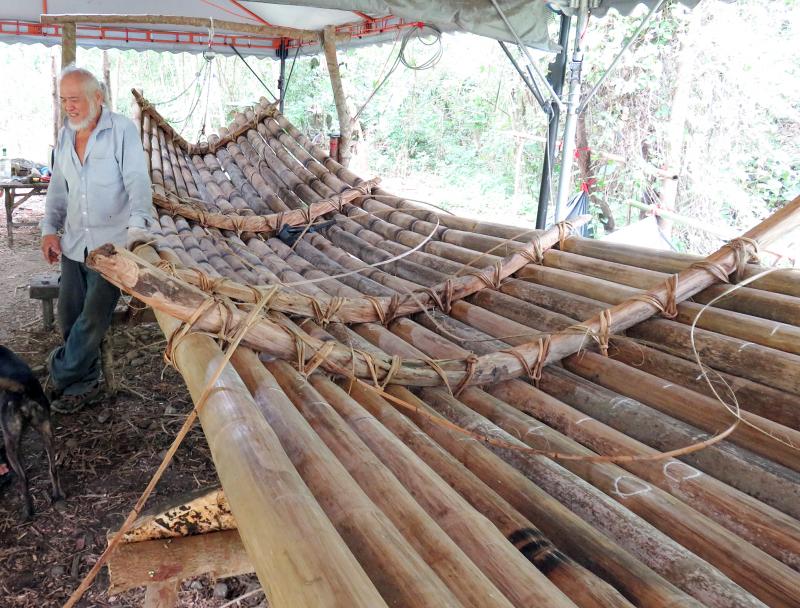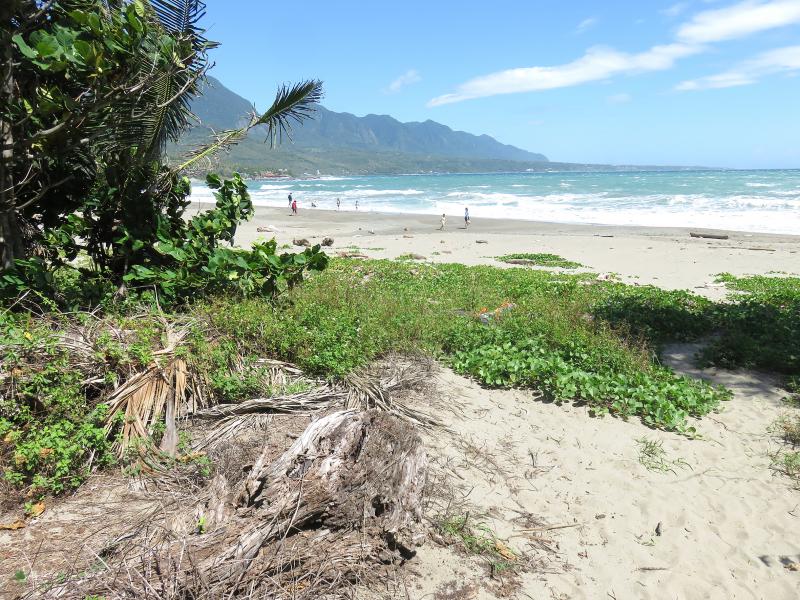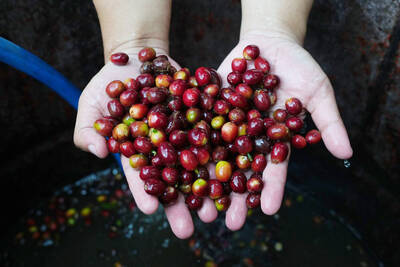It’s not even a road yet. At the moment it is merely a hint of upturned sod off Highway 11. When I visited last week the digger was sitting there unattended for the holiday. And yet, there it was, terrifying.
On the site plan the locals obtained, the road goes down to the south end of Taitung County’s Shanyuan (杉原) Beach. That beach now hosts the infamous Miramar hotel, built on land taken from aborigines by the government in 1987 and handed over to a developer to build a hotel in 2004 as a build-operate-transfer (BOT) project.
The hotel became the focus of a bitter struggle between environmentalists and developers over the potential destruction of one of the most beautiful and unique stretches of beach and bay in Taiwan, where the coast’s notorious rip is far from the beach, and Indian Ocean corals and sea turtles may be found.

Photo: Michael Turton
Today the abandoned Miramar is a ghastly bright corpse in the center of the beach, a bit back from the water, but not out of the reach of typhoons. It was repurchased from the developer by the county government last year, seemingly ending the long battle. The building is empty, but part of the parking lot is used.
Originally the Miramar plans called for villas running north from the main building, and to the south, much closer to the water on a shelf of sand, another hotel building, roughly the size of the first. That second building, as one quickly learns when walking over the area, would have been an easy target for a big typhoon.
The villas were given up first as the developer attempted to compromise with environmentalists and keep the main building. The second was never started.

Photo: Michael Turton
The original plans also called for a long, high wall to seal off the local community, Fushan (福山) in Beinan Township (卑南), from the beach. Comically, locals were assured they could still access the beach by walking around the community along Hwy 11 to the hotel and then cutting through the parking lot. That was all defeated.
The new road, still in its infancy, follows the southernmost access road from Highway 11 on the old plans for the second Miramar building. The second stage of its plan has the road turning north parallel to the shoreline, roughly following the old second hotel’s access road, swinging around the community along the beach, then hooking up with the existing Miramar parking lot.
That new road will be built next to the sand, in a stretch where typhoons regularly deposit large chunks of driftwood and other objects. Buried in a clump of trees where the road will pass are the remains of concrete foundation that slid into the sand after a storm. The locals I talked to are all convinced that the first big typhoon will take that road out.

Photo: Michael Turton
They are also suspicious that losing the road is part of the plan. Then the contractors will argue that they have to repair it and add a seawall or big concrete jacks to protect it. That road-and-wall combination will effectively isolate the community. It will then be much easier to build something on the beach.
When the Miramar was first constructed, several homes were in the zone slated for demolition. Those individuals were simply given eviction notices, with no explanation, warning or promises of help. That is what sparked the locals to learn to fight back.
For the road, things are similarly mysterious. There is no notice board describing the project near where the digger is working. The locals assured me that none of them has heard of an Environmental Impact Assessment (EIA) for it.

Photo: Michael Turton
Taiwan’s morass of land ownership, authority, and local corruption makes this possible. The central government has immense power but it is distant.
Fushan is home to an Amis indigenous community, who call it Fudafudak. The residents are “squatters” on land owned by the county and central governments. Years ago some people were able to obtain title, but many did not. Shanyuan Beach was once part of their traditional fishing grounds. Today they are struggling to find land for homes for their young people.
Ironically, they are “squatters” on what was once their own land, though some of the houses have been there nearly 90 years. Because they are “squatters,” they are at the mercy of any developer who can convince the local government to part with the land.

Photo: Michael Turton
Quite the romance: development and colonialism, holding hands and walking on the beach.
I borrowed a scooter and zoomed up Hwy 11. Just north of the hotel, where there is a stretch of coral rocks on the beach, the government is constructing a wastewater processing plant right on the beach.
“For the local community,” I was told by one of the workers.
A quick scooter trip into the hills above and around the beach suggested something else: four or five large hotels are going up in those hills. The defeat of the Miramar had a salutary effect: it gave the developers pause and work on the hotels was halted.
Today work is resuming. I scootered up to a place where there used to be a wooden observation tower with an excellent view of the bay. Now the tower site is cleared ground, though the marker for it is still there. Behind the marker a simple wire fence marks the land that will host a new hotel. The builders have slashed roads through the brush and trees on the slope.
It is obvious what wastewater is going to go into that plant: hotel wastewater. The plant sits right on the bay, and the wastewater will likely be dumped right into it. Indeed, a giant hole has already been dug in the sand for the project.
Once the bay is destroyed, there will be much less incentive to protect anything that is left. Then the developers can move in. The new road will then be there next to the beach, a ready link to a new project on that shelf of sand the last developer looked so hungrily at.
Today the Miramar sits, waiting. The locals assure me that nothing has ended. The developers will simply wait them out. The county will eventually sell off the building to another developer, they say, and the cycle of destruction will begin anew.
The developers can wait forever, if necessary. The media will move on, the activists turn to something else, the locals refocus on their lives, but the developers?
Developers are as inexorable as death.
Notes from Central Taiwan is a column written by long-term resident Michael Turton, who provides incisive commentary informed by three decades of living in and writing about his adoptive country. The views expressed here are his own.

Climate change, political headwinds and diverging market dynamics around the world have pushed coffee prices to fresh records, jacking up the cost of your everyday brew or a barista’s signature macchiato. While the current hot streak may calm down in the coming months, experts and industry insiders expect volatility will remain the watchword, giving little visibility for producers — two-thirds of whom farm parcels of less than one hectare. METEORIC RISE The price of arabica beans listed in New York surged by 90 percent last year, smashing on Dec. 10 a record dating from 1977 — US$3.48 per pound. Robusta prices have

The resignation of Taiwan People’s Party (TPP) co-founder Ko Wen-je (柯文哲) as party chair on Jan. 1 has led to an interesting battle between two leading party figures, Huang Kuo-chang (黃國昌) and Tsai Pi-ru (蔡壁如). For years the party has been a one-man show, but with Ko being held incommunicado while on trial for corruption, the new chair’s leadership could be make or break for the young party. Not only are the two very different in style, their backgrounds are very different. Tsai is a co-founder of the TPP and has been with Ko from the very beginning. Huang has

A few years ago, getting a visa to visit China was a “ball ache,” says Kate Murray. The Australian was going for a four-day trade show, but the visa required a formal invitation from the organizers and what felt like “a thousand forms.” “They wanted so many details about your life and personal life,” she tells the Guardian. “The paperwork was bonkers.” But were she to go back again now, Murray could just jump on the plane. Australians are among citizens of almost 40 countries for which China now waives visas for business, tourism or family visits for up to four weeks. It’s

A dozen excited 10-year-olds are bouncing in their chairs. The small classroom’s walls are lined with racks of wetsuits and water equipment, and decorated with posters of turtles. But the students’ eyes are trained on their teacher, Tseng Ching-ming, describing the currents and sea conditions at nearby Banana Bay, where they’ll soon be going. “Today you have one mission: to take off your equipment and float in the water,” he says. Some of the kids grin, nervously. They don’t know it, but the students from Kenting-Eluan elementary school on Taiwan’s southernmost point, are rare among their peers and predecessors. Despite most of